
Canada will soon be associated with a new kind of leaf.
The legalization of cannabis has led to important questions, most of which have yet to be answered. A growing number of Laurier researchers are dedicated to shedding light on the topic and separating fact from fiction.
Cannabis contains numerous cannabinoid chemicals, including tetrahydrocannabinol (THC) and cannabidiol (CBD). THC is responsible for most of the psychoactive effects of cannabis. The human brain has receptors for THC-like substances that produce the intoxicating effects of cannabis after consumption. Those receptors, along with THC-like chemicals produced naturally by the brain, make up the brain’s endocannabinoid system.
Laurier behavioural neuroscience Associate Professor Paul Mallet has been conducting groundbreaking research on issues related to cannabis and the function of the brain’s endocannabinoid system for more than 20 years.
“One of the first research questions I examined was whether cannabis affects memory by interacting with the brain’s endocannabinoid system,” Mallet says. “Specifically, I wondered if there was a link between a cannabis-like neurochemical called anandamide and memory.”
Mallet's research provided the first-ever evidence that the brain’s natural endocannabinoid system played a role in short-term memory.
“After that finding, my research focus shifted to the long-term ramifications of repeated THC use on cognitive functions including memory,” Mallet says.
His findings demonstrated that long-lasting cognitive defects are associated with chronic exposure to THC, especially when the exposure occurs at a young age.
“Our research has shown that heavy cannabis use can be especially damaging to the young brain and likely even for those in their 20s,” Mallet says. “The changes in brain function and cognitive abilities are subtle, but can include a wide range of issues such as impaired learning and increased anxiety. Others have also shown that heavy cannabis use is associated with an increased propensity for psychiatric disorders, poorer educational outcomes and lower IQ.
"Our research has also shown that exposure to THC at a young age increases the effects of other classes of drugs, such as heroin, in adulthood, which may increase the vulnerability to developing substance abuse disorders long after heavy cannabis use has ended.”

Bruce McKay, associate professor of neuroscience in Laurier’s psychology program, researches drug use in adolescence. His work reinforces Mallet’s findings.
“Cannabis use, just like alcohol, is especially harmful for teenagers and university-aged people,” McKay says. “This age group is already at a higher risk for the onset of certain mental illnesses. Cannabis use can not only cause those symptoms to appear earlier but can also amplify symptoms.”
McKay says there is an addictive effect to chronic cannabis use.
“Cannabis is addictive in the sense that when someone addicted stops using, their body reacts in ways such as changes in sleep habits and mood changes,” McKay says. “An addiction to cannabis can also present itself in unique ways. Sometimes users don’t understand the correlation between their drug use and the negative behaviours it’s creating.”
Cannabis can cause users to experience an increase in anxiety or panic attacks and become demotivated. McKay says public education will be key to informing Canadians how to use the drug responsibly.
Cannabidiol, the other major cannabinoid chemical compound in cannabis, is non-intoxicating and the chemical responsible for the medicinal effects related to cannabis use. Cannabis, in large part due to CBD, has been used to effectively treat a variety of ailments, McKay says, including arthritis pain, as well as to stimulate appetite in chemotherapy patients and even help manage anxiety.
“Cannabis doesn’t interact negatively with prescription medication like alcohol does and can replace the benefits of more dangerous substances like opiates,” McKay says.
Mallet hopes the legalization of cannabis will mean an increase in research and funding to provide answers to questions about the effects of the drug, as well as the medicinal benefits it can provide.
“With the upcoming legalization of cannabis for recreational use, it’s important that we direct resources into better understanding how cannabis use impacts the physical and mental health of young Canadians in particular,” Mallet says. “Some of the proceeds from tobacco and alcohol sales are used for research on these substances, but so far there have been few promises by either the federal or provincial governments to channel any revenues from recreational cannabis sales into the important research that is needed.”
For people interested in exploring cannabis for medicinal purposes, McKay says, “it’s best to speak to your doctor to find out if cannabis is the right treatment for your symptoms.”
The anticipated economic boom associated with the legalization of cannabis is providing opportunity for investors, researchers and even small business owners. Canadian cannabis production companies are already positioned to become leaders in the industry internationally.
Laurier researcher Sarah Wilner, associate professor of marketing at the Lazaridis School of Business and Economics and Laurier chair in brand communication, ventured to Colorado in 2014 after the state legalized recreational use of the drug to study the emerging cannabis economy and how businesses were tackling the stigma surrounding the drug through marketing and branding initiatives.
“Cannabis is a product that historically has been very stigmatized,” Wilner says. “Also, the prime way most people think about its consumption is by smoking, but public health initiatives have spent the last 50 years trying to stop people from smoking. So the growth opportunity for cannabis is in creating products that are consumed in other ways.”
Through product design, packaging and marketing, companies are changing the way cannabis can be consumed. Wilner says Dixie Elixirs, Mary’s Medicinals and Jane’s Brew are just a few examples of companies leading the industry in branding and packaging in the U.S.
“I was seeing cannabis products developed in a variety of new formats, like energy drinks, single-use coffee pods and even cannabis patches that allow the active ingredients to be absorbed into the skin,” Wilner says. “There is a real effort in the industry to think of cannabis as a consumer packaged good that requires thoughtful branding.”
Still, Wilner says purchasing recreational cannabis products in Colorado, Oregon and Washington state – which were all examined in her research – is extremely regulated. Products can only be sold at dispensaries and are kept behind glass. Proof of age must be presented at the door in order to enter.
“As a researcher of product design and branding, it’s an exciting time see an entire industry being created from scratch, and particularly one that has a legacy of negative associations,” Wilner says. “It’s not often you get to see the invention of a new industry. I’m looking forward to seeing how the same issues will manifest in the Canadian context.”